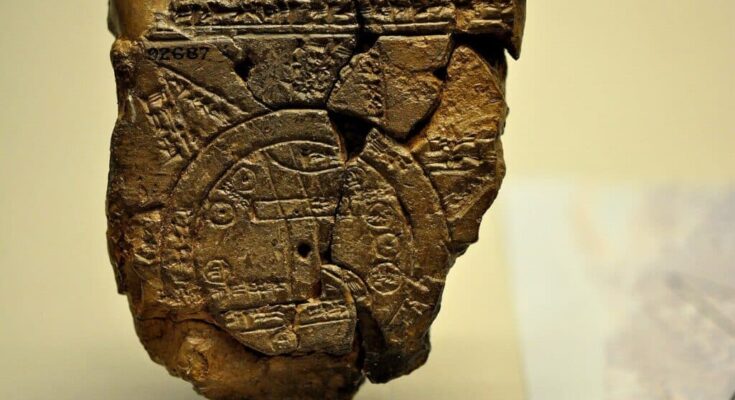
A new video from the British Museum highlights the Imago Mundi, the oldest known world map discovered on a clay tablet from Babylon. The babylonian oldest map, dating back to around the seventh century BC, offers a fascinating glimpse into the beliefs and worldview of the Babylonians.
Researchers found the tablet in the southern Iraqi city of Abu Habba, also known as Sippar. The British Museum has owned this significant piece since 1882. For many years, it remained a mystery until curators recently uncovered a missing section and decoded the writing.
Interpretation from the cuneiform tablet
The cuneiform tablet from the 6th century BC shows a bird’s-eye view of Mesopotamia, the area known as the “land between the rivers” in modern Iraq. In addition to mapping this familiar region, the tablet also represents places the Babylonians thought existed outside their immediate knowledge.
On the back of the tablet and above the map, there are several paragraphs written in cuneiform. These describe the creation of the Earth and what the scribe imagined existed beyond it.
Babylonians homeland at the center of the world
Researchers note that the circular diagram surrounding Mesopotamia indicates that the Babylonians viewed their homeland as the center of the world. The map prominently features the Euphrates River flowing through the region. A double ring encircles Mesopotamia, referred to by the ancient scribe as the “bitter river.”
This river marked the boundaries of the known world for the Babylonians. Inside the Bitter River, small circles and rectangles represent various cities and tribes, including Babylon, while another rectangle signifies the Euphrates.
Significance of the circular diagram
The Babylonian scribe did not only map their surroundings. They also included references to well-known stories, including their version of the biblical tale of Noah’s Ark.
According to Babylonian belief, the remains of a massive ark built by their Noah, named Utnapishtim, were located on the backside of a mountain. This mountain is the same one mentioned in the Bible as the resting place of Noah’s Ark, situated beyond the Bitter River.
British Museum curator and cuneiform expert Dr. Irving Finkel remarked on this fascinating connection, noting that it illustrates how these stories influenced one another. “That’s quite a meaty thing, quite an interesting thing to think about because it shows that the story was the same, and of course, that one led to the other.”
Babylonian’s faith in their creator
The tablet also reveals the Babylonians’ faith in their creator god, Marduk, along with their belief in mythical creatures. Among these are the scorpion-man and a lion-headed bird known as Anzu. This blend of geography and mythology showcases the rich imagination of the Babylonians and their complex understanding of the world around them.



